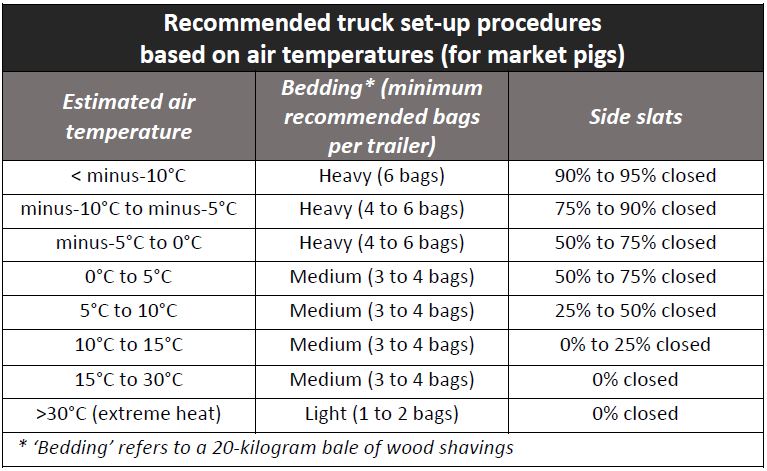

So far this summer in Alberta, extreme heat has not been an issue, but every summer, hot spells and humidity can quickly pose a challenge for maintaining animal welfare in transportation.
For example, in the week ahead, weather forecasts for much of the central and southern regions of the province are predicting temperatures upwards of 30 degrees Celsius and greater than 50 per cent humidity, at times. Per the chart below, these conditions would be considered “Alert”- or even “Danger”-worthy.
When it’s hot and humid, utmost attention and care is required for hogs. When loading your trailer, consideration must be given to bedding and ventilation, per the recommendations below.

Unlike humans, pigs are not able to regulate their body temperature by sweating. If you are hauling hogs, check out our Hauling Hogs in Extreme Heat fact sheet to learn what to do, and what not to do, during this naturally stressful time.
Livestock transporters are legally obligated to follow the Health of Animals Regulations, as part of the Health of Animals Act. Of note in this case are the requirements for feed, water and rest. Additionally, the National Farm Animal Care Council’s (NFACC) Code of Practice for the Care and Handling of Pigs Section 8.6 includes recommendations for hog transport.
It is important that anyone transporting pigs is familiar with all requirements and recommendations prior to embarking on a road trip. Please take care to review this information before heading out, and before the situation becomes urgent.
- Check the weather forecast before planning your trip.
- Select the best time to make the trip, considering the temperature at departure and expected arrival.
- Considering setting up the trailer with wet bedding according to the temperature recommendations outlined on Page 33 of your seventh-version Transport Quality Assurance (TQA) program manual and in the chart shown above. This is recommended only in hot weather.
- Reduce the load density (amount of hogs in the trailer at one time). For example, hogs weighing 300 pounds (or 136 kilograms) should be given five square feet (or 1.5 square metres) of space each, per the recommendations outlined on Page 29 of your seventh-version TQA program manual.
- If the temperature is above 27-degrees Celsius, wet the pigs during or after loading them. Note: excess humidity could have an opposite effect! Use water sparingly, allowing pigs to dry before being wetted again.
- Do not apply a large amount of cold water to an overheated pig, as this can shock and kill the animal. Always use a light mist or low flow of water.
- Once your trailer is loaded, travel as quickly as possible to your destination. Do not make stops along the way for any other business or leisure.
- Keep the truck in motion as much as possible to maintain airflow through the trailer.
- When you need to stop the truck, avoid parking near other large objects that block airflow or compromise biosecurity, including other animal transport trucks. If possible, remove trailer panels to maintain airflow, and if you are waiting at an abattoir, take advantage of any water sprinklers and fan banks available.
- If the weather changes during the transport, remove or add trailer panels to accommodate the variable temperature in the trailer.
- If you would like additional hands-on instruction regarding hog transport, Alberta Pork provides TQA training free-of-charge, in addition to providing an overview of humane transport requirements under the federal Health of Animals Regulations.
For questions about hog transport in Alberta, including the TQA program, please contact Cristina Neva, Quality Assurance and Production Specialist, Alberta Pork by email at cristina.neva@albertapork.com or by phone at 780-440-8459, toll-free at 1-877-247-PORK (7675).




